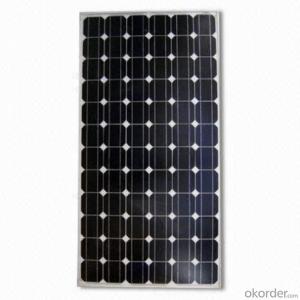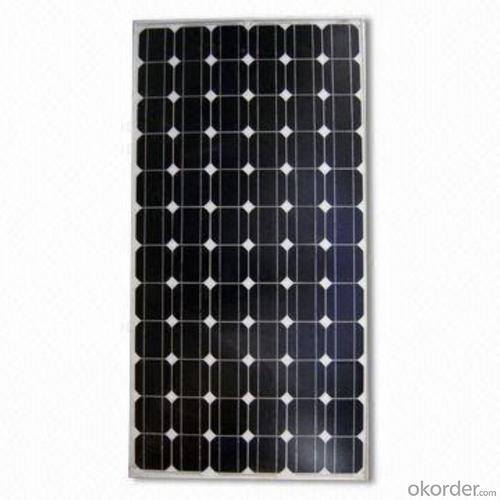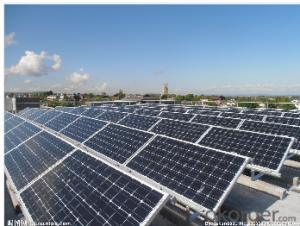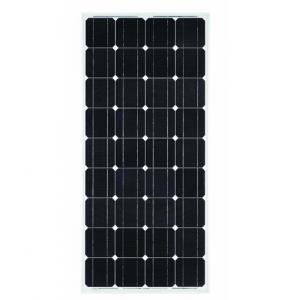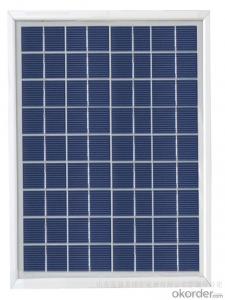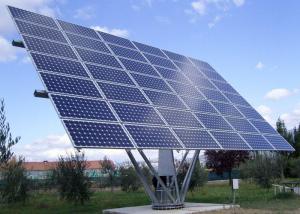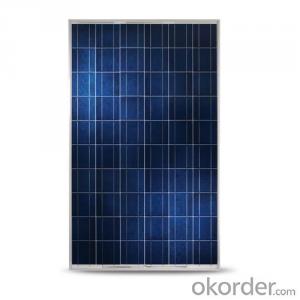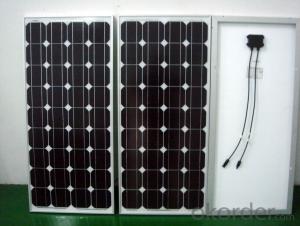Non Roof Solar Panels 250w with TUV IEC MCS CEC IDCOL SONCAP Certificates
- Loading Port:
- Shanghai
- Payment Terms:
- TT OR LC
- Min Order Qty:
- 1000 watt
- Supply Capability:
- 100000000 watt/month
OKorder Service Pledge
OKorder Financial Service
You Might Also Like
- TUV IEC, MCS (UK), CE, CEC (Australia), INMETRO, IDCOL, SONCAP CERTIFIED
- [EU ANTIDUMPING DUTY-FREE]
- PROFESSIONAL SOLAR PANEL MANUFACTURER SINCE 2004
FEATURES
`Long Service Life
`High Efficency Solar Cells
`Special Aluminum Frame Design
`High Transmission,Low Iron Tempered Glass - TUV IEC, MCS (UK), CE, CEC (Australia), INMETRO, IDCOL, SONCAP CERTIFIED
- [EU ANTIDUMPING DUTY-FREE]
- PROFESSIONAL SOLAR PANEL MANUFACTURER SINCE 2004
FEATURES
`Long Service Life
`High Efficency Solar Cells
`Special Aluminum Frame Design
`High Transmission,Low Iron Tempered Glass
`Advanced Cell Encapsulation
APPLICATIONS
`Solar power stations
`Rural electrification, Small home power systems
`Power supply for traffic, security, gas industry
`12V and 24V battery charging system
`Other industrial and commercial applications
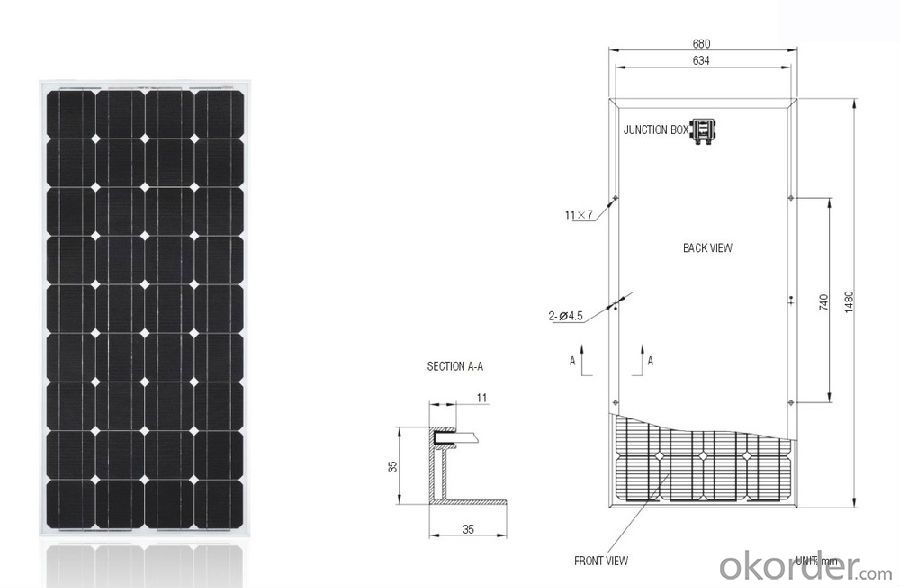
| ELECTRICAL CHARACTERISTICS | |||||||
| Model Number | KM(P)230 | KM(P)235 | KM(P)240 | KM(P)245 | KM(P)250 | ||
| Maximum Power as per STC | Pmax(W) | 230 | 235 | 240 | 245 | 250 | |
| Power Tolerance | % | ±3% | |||||
| Maximum Power Voltage | Vm(V) | 30.48 | 30.6 | 30.66 | 30.98 | 31.29 | |
| Maximum Power Current | Im(A) | 7.6 | 7.68 | 7.83 | 7.91 | 7.99 | |
| Open Circuit Voltage | Voc(V) | 36.6 | 36.72 | 36.84 | 37.38 | 37.5 | |
| Short Circuit Current | Isc(A) | 8.17 | 8.23 | 8.32 | 8.42 | 8.5 | |
| Maximum System Voltage | VDC | 1000 | |||||
| Cell Efficiency | % | 15.8 | 16.1 | 16.4 | 16.8 | 17.1 | |
| Module Efficiency | % | 14.1 | 14.4 | 14.7 | 15.0 | 15.3 | |
| Cells per Module | Pcs | 60 | |||||
| Cell Type | Polycrystalline silicon | ||||||
| Cell Size | mm | 156 x 156 | |||||
| Bypass Diodes | Pcs | 12Amp, 6 pcs | |||||
| Max. Series Fuse Rating | A | 15A | |||||
| Temperature coefficient of Isc | %/°C | 0.05 | |||||
| Temperature coefficient of Voc | %/°C | -0.35 | |||||
| Temperature coefficient of power | %/°C | -0.47 | |||||
| NOCT- Nominal operating cell temperature | °C | 47 ± 2 | |||||
| Operating Temperature | °C | -40 ~ +85 | |||||
| MECHANICAL CHARACTERISTICS | |||||||
| Dimensions | mm | 1650 x 990 x 50 | |||||
| Weight | Kg | 19.8 | |||||
| Type of Junction Box | TUV certified, IP65 | ||||||
| Cable Type, Diameter | TUV certified, 4mm2, 90 cm in length | ||||||
| Connector | compatible to Type 4 (MC4) | ||||||
| Tempered Glass | 3.2 mm, high transmission, low iron | ||||||
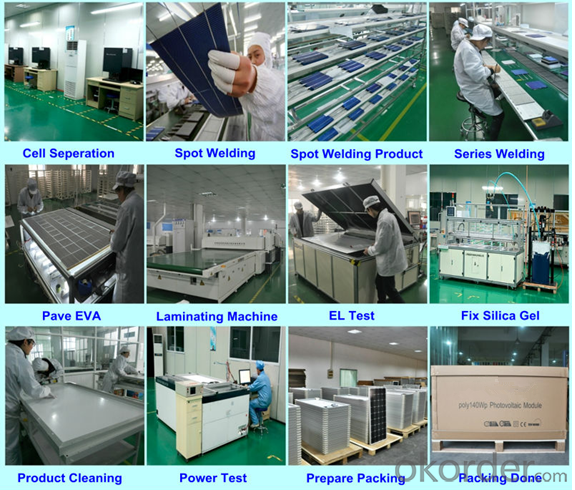 Packing
Packing
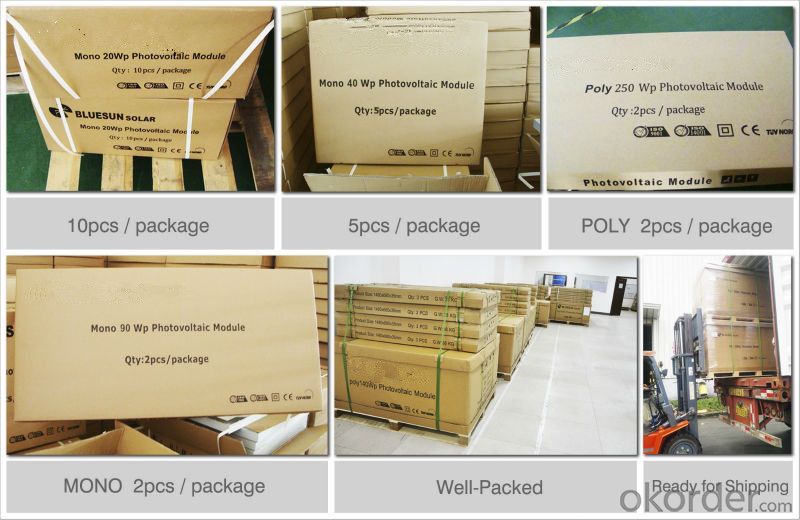
FAQ
1. What kind of Solar Cells does it have
---poly crystalline 156*156mm and 125*125mm or mono 125*125mm and 156*156mm
2. Is the front panel Glass or Plastic
---Tempered glass 3.2mm thickness or adjust to what you need, Light transmittance up to 95%.
3. Does it meet Europe Standards for Solar Energy
---This is TUV approval products, all the producing procedure apply TUV&UL.
4. What is the Efficiency level
--- Between 16-18.9% for solar cells.
5. What is the Nominal Voltage
--- 18v 20v 24v 36v 30v 48v , and so on, we can adjust to what you need.
6. What is the Warranty Period, How many years?
Power efficiency warranty:
---90% in 10 years; 80% in 25 years.
- Q: I am researching several solar panels to install in my house. I would like to use a 40 watt panel to connect, through a solar battery controller, to a battery or two. I would then like to use the solar panel (40 watts) to charge the battery(ies) for emergency use. Once charged, and when needed, I would like to use the battery(ies), 2 volt deep cycle, to power several LED lamps. Since I am new to solar power I had several questions...Is a 40 watt panel strong/large enough to charge a 2 volt deep cycle battery or two?How long would it take to charge one of these batteries?What would be the expected cost to purchase necessary supplies? (With the solar panel, battery controller, and MC4 cabling I've found I have an expected cost of roughly $00.00 with batteries)Would this be difficult for someone with little experience in this field?
- Whats the size of battery ? The time needed for your 40Watts panel to fully charge a battery depends on the size of battery. Usually battery size is mentioned in Amp-Hours (AH).
- Q: I have a rental property and use a 230-Volt 6-Amp Pool Pump.I would like to use a solar panel to run it when the house is empty, using mains power when guests are here.The building is in the Caribbean so plenty of sun!!I wanted to run it quot;directand not use batteries. Is this possible??What size panel would I need? A DC invertor too??Thanks!!
- Why don't you use the mains as the battery with net metering. That way you don't have to have two pumps, a DC pump for the solar and an AC pump for the mains. A 230 V, 6 A pump draws 3.68 kw. A typical solar panel produces about 400 watts so you would need about 0 solar panels which should run you about $20,000 US. Of course, you may not need to run the pump continuously but in order to use fewer solar panels for sporadic use, you would need the batteries or the net metering. Keep in mind that with the costs of the panels, you will be paying about 38 cents a kwh. Grid power usually costs around 5 cents a kwh.
- Q: What are the different applications for solar panels for residential use? How many should I purchase if the avg panel produces 80 watts .
- Let me start off by saying we (my family and I) live completely, 00% “off of the grid and are completely self sufficient” The house is built utilizing natures natural elements, in the shape of an octagon with 8ft wide arch doors on every wall to catch every angle of wind (typical 4 sided homes have half the chance as one with 8 sides.
- Q: I have 2 solar panels one is 5 watts 2 volts .2 amps or -The other is 50 watts 2 volts 2.6 amps or-Can I ...and what is the best way to hook them togeather to increase my amps being put back to my battery ?? I would be hooking them up to a 7 amp 00 watt charge controllerThe panels are rated 2 volt but the specs say they will produce more whennot connected to charge controllerPlease advise and should I even bother with the smaller panel ?
- You should probably ask this in the electronics section.
- Q: Are solar panels environmentally friendly?
- Yes, solar panels are environmentally friendly. They produce clean and renewable energy by converting sunlight into electricity, resulting in reduced greenhouse gas emissions and air pollution compared to fossil fuel sources. Additionally, solar panels have a long lifespan and can be recycled, further minimizing their environmental impact.
- Q: I would like to know how do you build a solar panel?
- At first, you will need about one square foot of thin copper plate, two alligator clips and short leads of wire, a wide mouth glass jar, tap water and salt. Cheers,
- Q: how much energy does solar panels save you? (like a month, year, etc)
- It depends on the size of the solar panels and the intensity of the solar-light. So, there's difference in every place. It's impossible to answer unless there's detail of panel size, panel quantities, average rainfall, average solar days, etc.
- Q: This is for my science project and i cannot figure it outWe assumed that blue light shining on a solar panel would give off the higher volt reading because it has the shortest wavelength and the highest energy, but it was actually the lowest. Why does this happen? Im very confused And cant find the answer anywhere.... ,thank you!!
- Likely there will be at least a small change in the no load volts. The short circuit current will be different and the watts output will be different. Connect an amp- meter to the panel with or without a to 00 ohm resistor in series with the amp-meter and you will see different amounts of current for different colors. You do however need to adjust for the amount of light falling on your solar panel. Possibly you can use a exposure meter or a bolo meter as reference. Neil
- Q: Can solar panels be used in areas with high levels of noise or vibration?
- Yes, solar panels can be used in areas with high levels of noise or vibration. Solar panels are designed to withstand various environmental conditions, including noise and vibration. However, it is important to ensure that the mounting structure and installation are done properly to minimize any potential impact on the panels' performance.
Send your message to us
Non Roof Solar Panels 250w with TUV IEC MCS CEC IDCOL SONCAP Certificates
- Loading Port:
- Shanghai
- Payment Terms:
- TT OR LC
- Min Order Qty:
- 1000 watt
- Supply Capability:
- 100000000 watt/month
OKorder Service Pledge
OKorder Financial Service
Similar products
Hot products
Hot Searches
